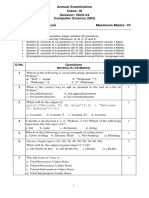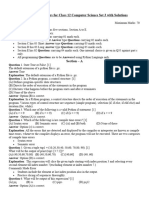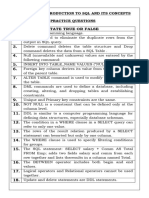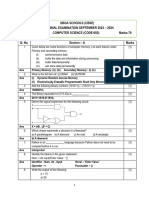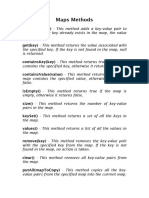Worksheet class 11 string
Uploaded by
Aniket DubeyWorksheet class 11 string
Uploaded by
Aniket DubeyWorksheet: Strings in Python
Section A: MCQs (1 Mark Each)
1. What is the output of the following code?
s = "Python"
print(s[1:4])
a) Pyt b) yth c) tho d) ytho
Answer: b) yth
2. Which of the following methods is used to remove any whitespace from the beginning or
the end of a string?
a) strip() b) split() c) replace() d) find()
Answer: a) strip()
3. What will be the output of the following code?
s = "hello"
print(s.upper())
a) HELLO b) hello c) error d) hELLO
Answer: a) HELLO
4. Which of the following is not a valid string method in Python?
a) upper() b) reverse() c) split() d) join()
Answer: b) reverse()
5. What is the result of the following expression?
"Python" * 2
a) Python2 b) Python Python c) PythonPython d) Error
Answer: c) PythonPython
Section B: Very Short Questions (2 Marks Each)
1. What is a string in Python?
Answer: A string in Python is a sequence of characters enclosed within single quotes (' ')
or double quotes (" "). Strings are immutable, meaning once defined, their contents cannot
be changed.
2. How can you access the last character of a string?
Answer: You can access the last character of a string using negative indexing. For
example, if s = "Python", s[-1] will return "n".
3. Explain the use of the find() method.
Answer: The find() method returns the lowest index of the substring if it is found in the
string. If not, it returns -1. Example: "hello".find("e") will return 1.
4. What does the split() method do in a string?
Answer: The split() method breaks up a string into a list based on a specified delimiter.
By default, the delimiter is whitespace. For example, "Hello World".split() will return
['Hello', 'World'].
5. What is string slicing in Python? Give an example.
Answer: String slicing is a way to extract a part of a string. The syntax is string[start:end],
where start is inclusive and end is exclusive. Example: "Python"[1:4] returns "yth".
Section C: Programming Questions (3 Marks Each)
1. Write a Python program to check if a string is a palindrome.
Answer:
def is_palindrome(s):
s = s.lower()
return s == s[::-1]
# Test the function
string = "Madam"
if is_palindrome(string):
print(f"{string} is a palindrome")
else:
print(f"{string} is not a palindrome")
2. Write a Python program to count the number of vowels in a given string.
Answer:
def count_vowels(s):
vowels = "aeiouAEIOU"
count = 0
for char in s:
if char in vowels:
count += 1
return count
# Test the function
string = "Hello World"
print(f"Number of vowels: {count_vowels(string)}")
3. Write a Python program to reverse a given string.
Answer:
def reverse_string(s):
return s[::-1]
# Test the function
string = "Python"
print(f"Reversed string: {reverse_string(string)}")
4. Write a Python program to replace all spaces in a string with an underscore (_).
Answer:
def replace_spaces(s):
return s.replace(" ", "_")
# Test the function
string = "Hello World"
print(f"Modified string: {replace_spaces(string)}")
5. Write a Python program to find the length of a string without using the len()
function.
Answer:
def string_length(s):
count = 0
for char in s:
count += 1
return count
# Test the function
string = "Hello"
print(f"Length of the string: {string_length(string)}")
Worksheet: Strings in Python (Part 2)
Section A: MCQs (1 Mark Each)
1. What will be the output of the following code?
s = "Python Programming"
print(s[::2])
a) Pto rgamn b) Pto rgamnin c) Pto rgamnig d) PthnPormig
Answer: d) PthnPormig
2. Which of the following expressions will return the string "Hello"?
a) ''.join(['H', 'e', 'l', 'l', 'o'])
b) '+'.join(['H', 'e', 'l', 'l', 'o'])
c) '-'.join(['H', 'e', 'l', 'l', 'o'])
d) ' '.join(['H', 'e', 'l', 'l', 'o'])
Answer: a) ''.join(['H', 'e', 'l', 'l', 'o'])
3. What does the rfind() method do?
a) Finds the first occurrence of a substring.
b) Finds the last occurrence of a substring.
c) Replaces all occurrences of a substring.
d) Replaces the first occurrence of a substring.
Answer: b) Finds the last occurrence of a substring.
4. What will be the output of the following code?
s = "hello"
print(s.capitalize())
a) HELLO b) Hello c) hellO d) hello
Answer: b) Hello
5. Which method would you use to check if a string starts with a particular substring?
a) startswith() b) endswith() c) find() d) index()
Answer: a) startswith()
Section B: Very Short Questions (2 Marks Each)
1. What is string immutability?
Answer: String immutability means that once a string is created, it cannot be changed.
Any operation that alters the string creates a new string object instead of modifying the
original one.
2. How do you concatenate two strings in Python?
Answer: Strings can be concatenated using the + operator. For example, "Hello" + "
World" results in "Hello World".
3. Explain the use of the replace() method in strings.
Answer: The replace() method returns a copy of the string where all occurrences of a
substring are replaced with another substring. Example: "apple".replace("a", "o") results in
"opple".
4. How do you find the length of a string in Python?
Answer: The len() function is used to find the length of a string. Example: len("Python")
returns 6.
5. What is the difference between isupper() and upper() in Python?
Answer: The isupper() method checks if all the characters in a string are uppercase and
returns a boolean. The upper() method converts all the characters in a string to uppercase
and returns a new string.
Section C: Programming Questions (3 Marks Each)
1. Write a Python program to remove vowels from a given string.
Answer:
def remove_vowels(s):
vowels = "aeiouAEIOU"
result = ""
for char in s:
if char not in vowels:
result += char
return result
# Test the function
string = "Programming is fun"
print(f"String without vowels: {remove_vowels(string)}")
2. Write a Python program to count the number of occurrences of a substring in a
given string.
Answer:
def count_substring(s, sub):
return s.count(sub)
# Test the function
string = "Hello, Hello, how are you?"
substring = "Hello"
print(f"Occurrences of '{substring}': {count_substring(string, substring)}")
3. Write a Python program to check if a given string starts with a vowel.
Answer:
def starts_with_vowel(s):
vowels = "aeiouAEIOU"
return s[0] in vowels
# Test the function
string = "Apple"
if starts_with_vowel(string):
print(f"{string} starts with a vowel")
else:
print(f"{string} does not start with a vowel")
4. Write a Python program to find the longest word in a given sentence.
Answer:
def longest_word(sentence):
words = sentence.split()
return max(words, key=len)
# Test the function
sentence = "Python programming is interesting"
print(f"Longest word: {longest_word(sentence)}")
5. Write a Python program to convert a given string to title case (each word starts with
a capital letter).
Answer:
def to_title_case(s):
return s.title()
# Test the function
string = "python programming language"
print(f"Title case: {to_title_case(string)}")
Worksheet: Strings in Python (Part 3)
Section A: MCQs (1 Mark Each)
1. What is the output of the following code?
s = "Python"
print(s[-6])
a) n b) P c) y d) h
Answer: b) P
2. Which method is used to return a copy of the string with leading and trailing whitespaces
removed?
a) rstrip() b) strip() c) lstrip() d) replace()
Answer: b) strip()
3. What will be the output of the following code?
s = "abcdef"
print(s.index("e"))
a) 3 b) 4 c) 5 d) Error
Answer: b) 4
4. What is the result of the following expression?
"Python" + "Rocks"
a) PythonRocks b) Python Rocks c) Error d) None of the above
Answer: a) PythonRocks
5. Which of the following will result in a string of all lowercase letters?
a) s.lower() b) s.islower() c) s.upper() d) s.capitalize()
Answer: a) s.lower()
Section B: Very Short Questions (2 Marks Each)
1. How do you check if a string contains only numeric characters?
Answer: You can use the isnumeric() method. If the string contains only numeric
characters, it returns True; otherwise, it returns False.
2. Explain the join() method with an example.
Answer: The join() method is used to join elements of a sequence (like a list or tuple) into
a single string, using a specified separator. Example: "-".join(['a', 'b', 'c']) results in "a-b-c".
3. What is the difference between rindex() and rfind()?
Answer: Both methods return the highest index of the substring if found. The difference is
that rfind() returns -1 if the substring is not found, whereas rindex() raises a ValueError.
4. How do you compare two strings in Python?
Answer: Strings can be compared using comparison operators like ==, !=, <, >, <=, and
>= based on lexicographical order (ASCII values).
5. Explain string formatting using the format() method with an example.
Answer: The format() method allows for variable substitution and formatting. Example:
"{} is {} years old".format("John", 25)
Output: "John is 25 years old"
Section C: Programming Questions (3 Marks Each)
1. Write a Python program to check if two strings are anagrams.
Answer:
python
Copy code
def are_anagrams(str1, str2):
return sorted(str1) == sorted(str2)
# Test the function
string1 = "listen"
string2 = "silent"
if are_anagrams(string1, string2):
print(f"{string1} and {string2} are anagrams")
else:
print(f"{string1} and {string2} are not anagrams")
2. Write a Python program to remove all special characters from a given string.
Answer:
import re
def remove_special_chars(s):
return re.sub(r'[^A-Za-z0-9 ]+', '', s)
# Test the function
string = "Hello! How@ are# you?"
print(f"String after removing special characters: {remove_special_chars(string)}")
3. Write a Python program to check if a given string is a valid identifier.
Answer:
def is_valid_identifier(s):
return s.isidentifier()
# Test the function
string = "my_variable"
if is_valid_identifier(string):
print(f"'{string}' is a valid identifier")
else:
print(f"'{string}' is not a valid identifier")
4. Write a Python program to print the frequency of each character in a string.
Answer:
def char_frequency(s):
freq = {}
for char in s:
if char in freq:
freq[char] += 1
else:
freq[char] = 1
return freq
# Test the function
string = "hello world"
frequency = char_frequency(string)
print(f"Character frequencies: {frequency}")
5. Write a Python program to reverse the words in a given sentence.
Answer:
def reverse_words(sentence):
words = sentence.split()
return ' '.join(reversed(words))
# Test the function
sentence = "Python is fun"
print(f"Reversed sentence: {reverse_words(sentence)}")
You might also like
- The C# Player's Guide - 5th Edition - 5.0.083% (18)The C# Player's Guide - 5th Edition - 5.0.0497 pages
- Ap Computer Science Principles Practice Exam and Notes 2021100% (4)Ap Computer Science Principles Practice Exam and Notes 2021108 pages
- Hacking The Art of Exploitation 2nd Edition Jon Erickson100% (19)Hacking The Art of Exploitation 2nd Edition Jon Erickson492 pages
- Binary File MCQ Question Bank For Class 12 - CBSE PythonNo ratings yetBinary File MCQ Question Bank For Class 12 - CBSE Python51 pages
- Python Revision Tour - Solutions of Computer Science With Python by Sumita Arora For Class 12 CBSE & NCERT - KnowledgeBoatNo ratings yetPython Revision Tour - Solutions of Computer Science With Python by Sumita Arora For Class 12 CBSE & NCERT - KnowledgeBoat44 pages
- Must Prepare Python File Handling MCQ Class 12 For Term 1No ratings yetMust Prepare Python File Handling MCQ Class 12 For Term 148 pages
- Class 11 Computer Science (Society Law and Ethics)No ratings yetClass 11 Computer Science (Society Law and Ethics)19 pages
- SQL Class 12 Notes CBSE Computer Science - Techt6No ratings yetSQL Class 12 Notes CBSE Computer Science - Techt629 pages
- I Pre-Board Exam Computer Science, 2024-25No ratings yetI Pre-Board Exam Computer Science, 2024-258 pages
- Data File Handling Application Based Questions AnswersNo ratings yetData File Handling Application Based Questions Answers2 pages
- Class 12 Computer Science Set 3 With SolutionsNo ratings yetClass 12 Computer Science Set 3 With Solutions14 pages
- imp CBSE Class 12 Computer Science Practical Viva Q Python 2024-20250% (1)imp CBSE Class 12 Computer Science Practical Viva Q Python 2024-20252 pages
- CH 7 - Introduction To SQL and Its Commands For Board ExamNo ratings yetCH 7 - Introduction To SQL and Its Commands For Board Exam28 pages
- GR 12 CH 3 Working With Functions NotesNo ratings yetGR 12 CH 3 Working With Functions Notes16 pages
- Class 11 - I Terminal Exam Final Paper-Answer KeyNo ratings yetClass 11 - I Terminal Exam Final Paper-Answer Key7 pages
- Q1 Write A Menu Driven Program To Implement The Following in Binary File Emp - Dat'No ratings yetQ1 Write A Menu Driven Program To Implement The Following in Binary File Emp - Dat'2 pages
- CHAPTER 13 - Boolean Algebra Class 12 2020 Cs Notes0% (1)CHAPTER 13 - Boolean Algebra Class 12 2020 Cs Notes36 pages
- Rewrite The Following Code Fragment That Saves On The Number of ComparisonsNo ratings yetRewrite The Following Code Fragment That Saves On The Number of Comparisons18 pages
- CBSE Sample Papers For Class 11 Computer Science Set 4 With SolutionsNo ratings yetCBSE Sample Papers For Class 11 Computer Science Set 4 With Solutions19 pages
- Coding With JavaScript For Dummies Everything To Know About JavaScript (2020) - 40153100% (1)Coding With JavaScript For Dummies Everything To Know About JavaScript (2020) - 40153247 pages
- A Comprehensive Analysis of Package Hallucinations by Code Generating LLMs [2406.10279]100% (1)A Comprehensive Analysis of Package Hallucinations by Code Generating LLMs [2406.10279]20 pages
- Learn To Code HTML and CSS Develop Style Websites PDF100% (2)Learn To Code HTML and CSS Develop Style Websites PDF595 pages
- C# Cheat Sheet PDF For Your Quick ReferenceNo ratings yetC# Cheat Sheet PDF For Your Quick Reference25 pages
- KMP Skip Search Algorithm: Advisor: Prof. R. C. T. Lee Speaker: Z. H. PanNo ratings yetKMP Skip Search Algorithm: Advisor: Prof. R. C. T. Lee Speaker: Z. H. Pan18 pages
- Java String Functions': Visit at "JH X.KS'KK Ue%"No ratings yetJava String Functions': Visit at "JH X.KS'KK Ue%"5 pages
- Ap Computer Science Principles Practice Exam and Notes 2021Ap Computer Science Principles Practice Exam and Notes 2021
- Hacking The Art of Exploitation 2nd Edition Jon EricksonHacking The Art of Exploitation 2nd Edition Jon Erickson
- Binary File MCQ Question Bank For Class 12 - CBSE PythonBinary File MCQ Question Bank For Class 12 - CBSE Python
- Python Revision Tour - Solutions of Computer Science With Python by Sumita Arora For Class 12 CBSE & NCERT - KnowledgeBoatPython Revision Tour - Solutions of Computer Science With Python by Sumita Arora For Class 12 CBSE & NCERT - KnowledgeBoat
- Must Prepare Python File Handling MCQ Class 12 For Term 1Must Prepare Python File Handling MCQ Class 12 For Term 1
- Class 11 Computer Science (Society Law and Ethics)Class 11 Computer Science (Society Law and Ethics)
- Data File Handling Application Based Questions AnswersData File Handling Application Based Questions Answers
- imp CBSE Class 12 Computer Science Practical Viva Q Python 2024-2025imp CBSE Class 12 Computer Science Practical Viva Q Python 2024-2025
- CH 7 - Introduction To SQL and Its Commands For Board ExamCH 7 - Introduction To SQL and Its Commands For Board Exam
- Q1 Write A Menu Driven Program To Implement The Following in Binary File Emp - Dat'Q1 Write A Menu Driven Program To Implement The Following in Binary File Emp - Dat'
- CHAPTER 13 - Boolean Algebra Class 12 2020 Cs NotesCHAPTER 13 - Boolean Algebra Class 12 2020 Cs Notes
- Rewrite The Following Code Fragment That Saves On The Number of ComparisonsRewrite The Following Code Fragment That Saves On The Number of Comparisons
- CBSE Sample Papers For Class 11 Computer Science Set 4 With SolutionsCBSE Sample Papers For Class 11 Computer Science Set 4 With Solutions
- Coding With JavaScript For Dummies Everything To Know About JavaScript (2020) - 40153Coding With JavaScript For Dummies Everything To Know About JavaScript (2020) - 40153
- A Comprehensive Analysis of Package Hallucinations by Code Generating LLMs [2406.10279]A Comprehensive Analysis of Package Hallucinations by Code Generating LLMs [2406.10279]
- Learn To Code HTML and CSS Develop Style Websites PDFLearn To Code HTML and CSS Develop Style Websites PDF
- KMP Skip Search Algorithm: Advisor: Prof. R. C. T. Lee Speaker: Z. H. PanKMP Skip Search Algorithm: Advisor: Prof. R. C. T. Lee Speaker: Z. H. Pan


































